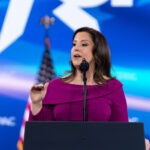Federal Education Funds Released After Political Pressure \ Newslooks \ Washington DC \ Mary Sidiqi \ Evening Edition \ The Trump administration has released over $6 billion in frozen education grants after political and legal pressure. The funding supports adult literacy, ESL classes, and summer programs. Officials confirmed disbursements will begin next week following an OMB review.

Quick Looks
- Trump admin had frozen $6B in school grants July 1
- Funding supports adult literacy, ESL, after-school programs
- Educators, lawmakers, and nonprofits filed legal challenges
- $1.3B released last week for summer and after-school care
- 10 GOP senators urged full release in a formal letter
- Programs serve low-income families, English learners, adult workers
- Funding essential for YMCA, Boys & Girls Clubs, and districts
- Harford County’s English camp faced budget crisis without funds
- OMB claimed “leftwing agenda” before clearing the programs
- Funds to be distributed to states starting next week
Deep Look
After weeks of mounting political pressure and legal challenges, President Donald Trump’s administration has reversed course and authorized the release of more than $6 billion in federal education grants, money that supports adult literacy, English as a Second Language (ESL) classes, and crucial after-school and summer enrichment programs. The Education Department confirmed the announcement on Friday, stating that the Office of Management and Budget (OMB) had completed its programmatic review and would begin distributing the funds to states in the coming week.
The grant freeze, initiated on July 1, drew immediate criticism from educators, school district leaders, and lawmakers on both sides of the aisle. Though the funds were already appropriated and included in a bipartisan bill signed by President Trump earlier this year, the White House ordered a halt to the disbursement as part of a broader administrative audit to determine whether certain programs were consistent with what OMB labeled “the president’s education priorities.”
The impact of the freeze was swift and deeply felt. School districts and nonprofit organizations, including well-established entities such as the YMCA and the Boys and Girls Clubs of America, warned that they would be forced to cancel or significantly curtail their programming without access to the promised funding. These organizations provide vital services to low-income families, working parents, and communities with high concentrations of English language learners. In some areas, the withheld grants accounted for more than half the budget of these programs.
One of the most visible examples of the freeze’s real-world impact occurred in Harford County, Maryland, where over 1,100 non-native English-speaking students participate in an annual summer camp designed to help children retain and strengthen their language and academic skills. Without federal support, Harford County officials feared the program would be shut down entirely. The camp employs certified teachers and integrates hands-on learning into recreational activities over four weeks each summer. The goal is not just to improve English proficiency but to keep children engaged academically while their parents work.
Last Thursday, just a day before the administration’s reversal, the halls of Bel Air High School were filled with over 350 young learners participating in the camp’s second-to-last day. Children gathered around an interactive alphabet wheel, pushing buttons labeled A through Z and calling out the names of foods that began with each letter. In another part of the school, middle schoolers watched a demonstration from a local robotics team, and high school volunteers—many of whom were once ESL students themselves—helped younger campers with art projects. For these students, the camp represents more than a summer diversion; it’s a bridge to academic success and cultural integration.
The release of $1.3 billion last week, earmarked specifically for summer and after-school programs, signaled a potential softening of the administration’s stance. But it wasn’t until ten Republican senators—including prominent figures with influence over education and budgetary policy—sent a direct letter to the White House urging full release of the funds that momentum visibly shifted. The senators acknowledged OMB’s concerns but insisted that the grants in question did not support any “radical leftwing agenda,” as initially suggested by OMB.
“The programs are ones that enjoy longstanding, bipartisan support,” said Senator Shelley Moore Capito (R-W.Va.), one of the leading voices urging the release. “They help parents stay employed and adults gain skills, while children receive the academic support they need to succeed.”
The letter from GOP lawmakers appears to have been a turning point. Within days, the Education Department announced that the full funding would be released. In a brief statement, the department said that OMB had concluded its review and determined that the programs met the necessary standards for alignment with the administration’s objectives.
The reversal highlights a growing tension within Trump’s second-term administration—between fiscal conservatism and populist priorities. While Trump has emphasized “America First” values and curbing what his allies often describe as liberal overreach in public institutions, he has also doubled down on expanding access to education and workforce development as part of his economic agenda. Programs that support English language learners and adult literacy fall directly in line with goals to reduce unemployment, improve workforce readiness, and bolster local economies.
Educators and advocates have cautiously welcomed the administration’s decision, though many remain wary. The AASA, the national school superintendents’ association, praised the decision and credited members of Congress for applying pressure. But the group also warned that trust had been shaken and called for more transparency in how education dollars are reviewed and distributed in the future.
Some policy analysts noted that the freeze may have been a political litmus test, designed to gauge the extent of opposition to funding tied to equity-based programs. The backlash, which came from both Republicans and Democrats, suggests that education funding—especially for at-risk groups—is one of the rare policy areas that still enjoys bipartisan protection.
As the funds begin flowing again, school districts across the country are scrambling to rehire staff, restore programming, and inform families of the renewed services. While the sudden reinstatement provides immediate relief, many administrators worry about what precedent this sets for future funding cycles.
President Trump, when asked about the decision during a press conference, deflected, citing his administration’s broader successes in reducing bureaucracy and ensuring “taxpayer money goes where it truly belongs.” Though he offered no direct comment on the potential political fallout, the decision to restore education funding is seen by some insiders as a strategic move to retain support among suburban and working-class voters heading into the midterm elections.
In the end, what began as a partisan standoff has turned into a testament to the power of political pressure and public accountability. For the students, families, and educators who rely on these funds, the return of support couldn’t come soon enough.
Federal Education Funds Federal Education Funds Federal Education Funds







